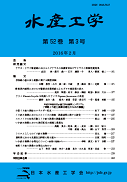55 巻, 1 号
選択された号の論文の11件中1~11を表示しています
- |<
- <
- 1
- >
- >|
-
2018 年 55 巻 1 号 p. 1-10
発行日: 2018年
公開日: 2019/01/01
PDF形式でダウンロード (1419K) -
2018 年 55 巻 1 号 p. 11-19
発行日: 2018年
公開日: 2019/01/01
PDF形式でダウンロード (1241K) -
2018 年 55 巻 1 号 p. 21-27
発行日: 2018年
公開日: 2019/01/01
PDF形式でダウンロード (1838K) -
2018 年 55 巻 1 号 p. 29-38
発行日: 2018年
公開日: 2019/01/01
PDF形式でダウンロード (1243K) -
2018 年 55 巻 1 号 p. 39-40
発行日: 2018年
公開日: 2019/01/01
PDF形式でダウンロード (561K) -
2018 年 55 巻 1 号 p. 41-49
発行日: 2018年
公開日: 2019/01/01
PDF形式でダウンロード (2775K) -
2018 年 55 巻 1 号 p. 51-57
発行日: 2018年
公開日: 2019/01/01
PDF形式でダウンロード (4273K) -
2018 年 55 巻 1 号 p. 59-63
発行日: 2018年
公開日: 2019/01/01
PDF形式でダウンロード (1891K) -
2018 年 55 巻 1 号 p. 65-70
発行日: 2018年
公開日: 2019/01/01
PDF形式でダウンロード (1171K) -
2018 年 55 巻 1 号 p. 71-75
発行日: 2018年
公開日: 2019/01/01
PDF形式でダウンロード (1344K) -
2018 年 55 巻 1 号 p. 77-82
発行日: 2018年
公開日: 2019/01/01
PDF形式でダウンロード (2239K)
- |<
- <
- 1
- >
- >|
